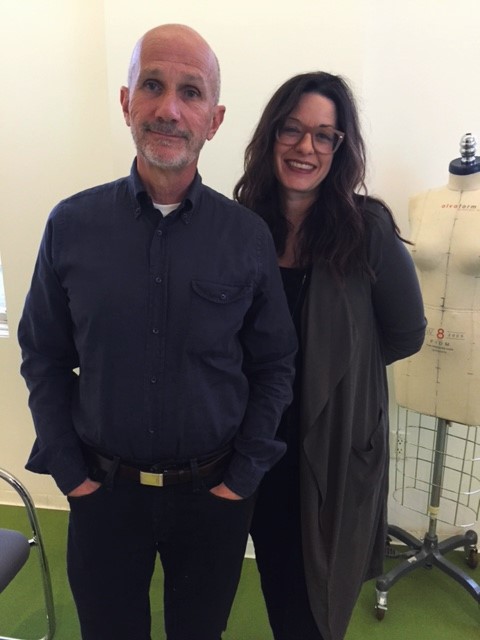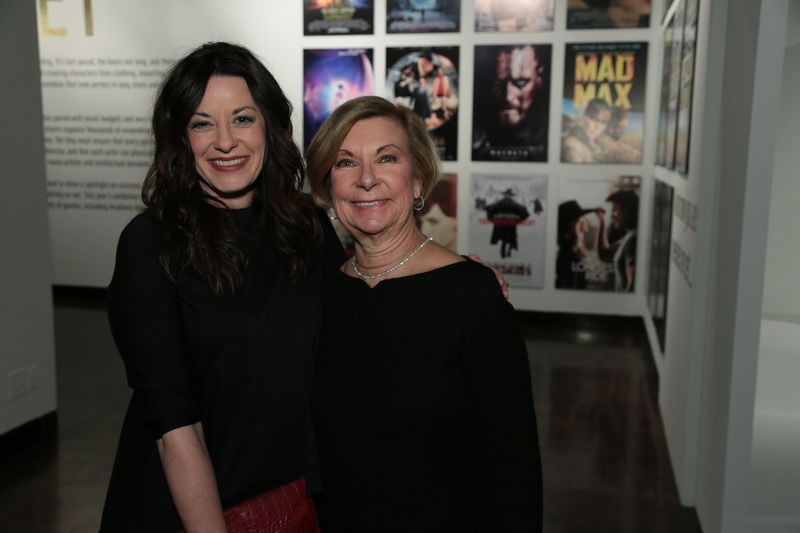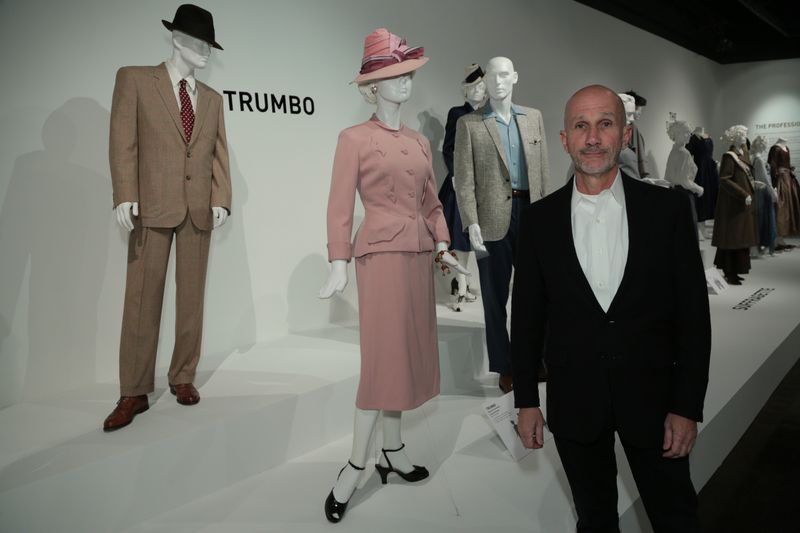Our annual Art of Motion Picture Costume Design exhibition gives us the opportunity to meet the incredibly talented designers behind our favorite films. We love to learn about their unique career paths, design processes, and what it’s really like to work on set. This year, costume designers Jenny Eagan (Beasts of No Nation) and Daniel Orlandi (Trumbo) spoke to FIDM students about their experiences in the film industry. Read below for highlights from their candid conversation.
Daniel Orlandi and Jenny Eagan on the FIDM LA Campus.
On their first costume design jobs:
Daniel Orlandi: I always wanted to be a set designer and costume designer. I went to theater school and then moved here with two friends from college soon after – we had worked in New York a little bit. I was doing sets. I got this call from a friend I went to school with. He was an assistant on this big Las Vegas show and he said, ‘can you come in for two days and help us with crafts projects?’ I went in and I met Bob Mackie. It just so happened he was looking for a new assistant, which was so weird. And then he hired me with no experience, which was also weird! I stayed with him, working only for him for eight years. He did television shows and then he started a fashion line.
I like doing characters, and I missed that. My friends who I went to college with came over one Sunday and said, ‘okay, it’s time for you to leave this job.’ They got me a design job – they were doing the sets, and they said, ‘we found someone and he’s really cheap!’
Then I worked as an assistant with other designers. We’d go back and forth doing little shows, TV movies, variety shows. Then I worked for other designers on movies – sometimes big movies, sometimes small movies. I think I became a good assistant because I could work any way – whatever they want you to do, however they want you to do it, I would say ‘yeah, I can do that.’
Jenny Eagan: I didn’t know this job existed when I moved out to San Diego. I went to University of Missouri and studied Marketing Merchandising in Texas. I moved to San Diego because I didn’t know what I was going to do with my life. I moved up here [Los Angeles] thinking I want to get into film. Somebody said, ‘you should do costumes,’ because I understood that a little bit. I started working in the office. Mary [Zophres] walked in on a very tiny budget picture and I said I want to do what you do – I’ll do anything, I’ll work for free. So I worked on the weekends for free for her. I would get them lunch, whatever they wanted or needed, I would go do it. And then she said, ‘I’ve got this big movie in Florida, you have to get there yourself, get a car, get a hotel.’ So I went. She said ‘you’ve got what it takes, you just have to keep working hard’ and I did. I worked as a PA for a long time, a couple of years. And then she brought me up. I think it’s all about hard work. People just want someone who is going to work hard and stand by them. You learn every second of everyday.
DO: We both started similarly. We worked as an assistant for a really long time. I learned a lot. I learned a lot from the people I was working for from their mistakes, as well as their successes.
JE: I think back to the beginning getting my first job – I begged! I always say to anybody who wants to get into any job: assist. As long as you can, as long as you feel comfortable. There was a point I wanted to get out and go on my own and start designing, but for whatever reason I didn’t and I stuck around a little longer, and I knew when I was done. I met a lot of producers. I met a lot of Union Production Managers, they help with the hiring, I met directors I met director’s assistants that moved up. Everybody comes up together. By the time I jumped, I walked into a meeting, my mentor Mary had recommended me, it was a lower budget movie, they were looking for someone who was willing to get paid less but eager and excited. I went in and I have my presentation and I looked at the director and said, please give me the job! I’ll do whatever it takes. They want somebody there that’s going to do anything to make their film great. Just have that enthusiasm.
Jenny Eagan with her costumes from Beasts of No Nation. Photo: ABImages
On Beasts of No Nation:
JE: We knew it was in Africa, the script didn’t have a place, a war, an army, anything. We based it on Commadores, they were bush fighters in Sierra Leone and Liberia around the time of ’94 to 2001. He [director Cary Joji Fukunaga] liked that look. It was colorful, it was interesting. They go through an initiation, which you see in the film, they get the necklace. The amulets are supposed to be like the Koran, they’re washed away and wrapped in yarn. It’s a protection. Now they’re protected from any weapons or bullets. If they do things like drugs or have sex, things that are sort of illegal within their system, they then buy more which become the hats. You see it on the commandant – this is a special protection.
The important part for me was aging it all, finding the resources. I bought a lot of fabric from northern Africa, they don’t really make it any more. It’s this woven fabric, the blue that the commandant wears. We used a lot of things – potato sacks, rice bags – we cut those things up. It’s all you can find. We’d just go to the market – is this going to be interesting? How can I make this beautiful and age it? A lot of it was the research, it really gave me a lot. I just didn’t know where we were going to get it or how we were going to make it!
I brought one person, my supervisor Emily. Emily was very resourceful…I needed somebody that’s just going to work. I didn’t know what I was doing, nobody knew what we were doing! Somebody that’s going to be fun to be around, that I’m going to have a bottle of wine with at the end of the week and say ‘what happened?!’ She was that for me. She broke her foot the second day she was there and wore a boot the entire time, through the jungle! She dressed all those guys every single day – she would be out dressing them among all the leaves and all that crazy stuff, and I would be back at base camp. Whether you’re fitting somebody, or tents would collapse, or all your racks would break, and everything would get wet because rain would just come out of nowhere! And the smell, oh my gosh our truck. We couldn’t wash the clothes. We had one washer, it was back at our office, and I didn’t have a dryer so everything had to be hung to dry. So they sort of aged themselves! The smell got to be unbearable. But you get through it, and it was so exciting in the end! It was really great.
On researching a project:
JE: It’s always nice to get a different perspective. If you can afford to hire somebody else, or if you’ve got a team of people and you ask your assistant, or you ask somebody else – because people love to research. It’s the best! It’s the most exciting time!
It’s such a collaborative effort. I think being a designer, one of the most important things is just being open to collaboration because it’s a team effort. You work to get to that level to call yourself a designer, but within that you need that team. They support you. If you give them those opportunities, you will shine, they will shine, and it just makes for a much better project. And what they bring sometimes, it might be the thing the lead actor wears, and that’s what’s exciting!
Jenny Eagan and FIDM Museum Director Barbara Bundy at the opening of the Art of Motion Picture Costume Design exhibition. Photo: ABImages.
On the differences between big budget and small budget films:
DO: They’re different and the same, just more money! It’s the same, it’s solving a problem, working with actors. An actor on a small budget movie doesn’t really care that it’s a small budget movie. And the director doesn’t care, for the most part. I never will be the person to tell the director no.
JE: On my bigger budget movies, I was an assistant. They give you a lot more money, but they expect a lot more and they expect it in a timely fashion, and then everyone is stomping around for a lot more. So I think the harder part is there are things people expect when they’re on a big movie.
DO: I don’t like anybody wasting my money, and I don’t like to waste the producer’s money. And I think producers appreciate that.
Daniel Orlandi with his costumes from Trumbo. Photo: ABImages.
On Trumbo:
DO: We made a lot of the clothes, which helps us in the end when things get lost that we rented. We made almost all of Trumbo’s clothes, we made three-quarters of Hedda Hopper’s clothes. Diane Lane wore mostly vintage clothes, except we made her a suit. So it’s always a combination. And then there’s certain things you have to make – we need cowgirls, or car hops. Those we have to make. I’m very careful. I like to spend all the money on the clothes. Even on a big budget movie, I’m like ‘why are you buying more sharpies!?’
On The DaVinci Code and Angels and Demons:
DO: This was a really fun project, we filmed in London for nine months. It was fantastic. They basically wear these two outfits for the whole movie! But we did all of these period flashbacks, the history of the Catholic Church, the Council of Nicaea. It was so much fun to do these – there were no actors in them, so it was just really making these beautiful pictures. We based some of them on Da Vinci’s paintings, the colors. It was really an amazingly fun job to work on. Angels and Demons, which was sort of the sequel, we had to recreate the Vatican. We made two hundred cardinals. We had all the stuff made by the people who make it in Rome. We had the Swiss Guard, those uniforms with all the patterns, and we found the tailor who makes them – and they were cheaper than we could have made them anywhere.
On The Blind Side:
DO: This was a really interesting project for me. In our first fittings, she’s playing a real woman, Leigh Anne Tuohy, who wore bright colors and bold prints. We started Sandra that way and it just looked vulgar and funny. What we did, we took all the color out of her clothes so she doesn’t wear any color – it’s all neutrals and navy blue, not even black. And then all of a sudden the character worked. The skirts could be too tight and she looked serious. That’s what the joy of working with an actor is – I love the process of working with an actor in a fitting. Even on a period film, I don’t like to dictate ‘here’s the sketch and this is what you’re wearing.’
On Down with Love:
DO: I really wanted this job. I went in and I designed the whole movie, I had sketched the whole movie, and I had all the research. I was the first one in, and I did this presentation and they said you’ve got the job! It was great, I’ll never forget it. It was really fun. It’s a takeoff on the Doris Day and Rock Hudson movies. We wanted it all to have that authentic 1960s fake vibe of those movies. Those were the first movies I saw as a kid, and I loved the way they looked. The fabric that’s on her dress is the same fabric as on the couch, even though she’s just seeing this apartment for the first time! That’s a really great collaboration with the production designer.




